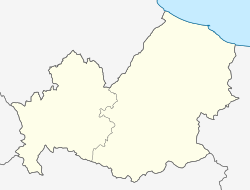Campobasso
Campobasso | |
|---|---|
| Comune di Campobasso | |
| Coordinates: 41°34′N 14°40′E / 41.567°N 14.667°E | |
| Country | Italy |
| Region | Molise |
| Province | Campobasso (CB) |
| Frazioni | Santo Stefano |
| Government | |
| • Mayor | Giuseppe Di Fabio (since June 14, 2004) |
| Area | |
| • Total | 56.11 km2 (21.66 sq mi) |
| Population | |
| • Total | 49,262 |
| Demonym | Campobassani |
| Time zone | UTC+1 (CET) |
| • Summer (DST) | UTC+2 (CEST) |
| Postal code | 86100 |
| Dialing code | 0874 |
| Patron saint | St. George |
| Saint day | April 23 |
| Website | www.comune.campobasso.it |
Campobasso Provincial capital of the Molise Region, which began at the foot of the Monforte Castle, today extends beyond the slopes of his “Mount” that dominates everything from above.The ancient medieval village with its churches, long flights of steps, narrow alleys, the silence and the aroma of bread from the old but still functional bakeries, speaks to the visitor of the austerity and the tenacity of its inhabitants. This ancient soul of the city contrasts with the elegance of the main centre with its pleasant main street, the beautiful apartment buildings, the avenues and the squares, which are worthy of the provincial capital’s title of “garden city”.Campobasso is a city of sincere spirit, strong and faithful to its traditions, alert to the challenges of society. It stretches out towards a bigger development, which the University of Molise contributes to; with its numerous faculties it proves a watchful and precise promoter of the socio-cultural shift that is underway.The presence of the Catholic University is important, with its “Centre for research and high specialisation for Biomedical Sciences” that has as its catchment area the population of centre-south Italy and is in the international forefront both in the diagnosis and treatment of numerous pathologies.Guido Piovene, about half century ago, in his “Trip to Italy” defined Campobasso as “rich, animated, modern... almost luxurious”.A city, therefore, where it its possible to live a quiet life, a place to discover and certainly to love.
History
The origins of Campobasso are still disputed. According to the most agreed theory, the city was founded before the 8th century as a fortified camp by the Lombards, on the steep of the hill where a castle is. The original name was Campus vassorum, meaning the city was in origin the seat of the vassals of the Duke of Spoleto.
After the Norman conquest of Southern Italy, Campobasso lost its connotation of a defensive strongpoint and gained a role as a trading and administration centre.
From 1330 to 1745 the city was ruled by the Monforte-Gambatesa, who built the castle and established a mint. Later it was ruled by the Di Capua, Gonzaga, Vitagliano, Carafa and Romano families.
In 1763 the citizens abandoned the old city and settled in the lower valley. The current city was expanded in 1814 by the King of Naples Joachim Murat, and lies on the Campo Basso ("Low field").
In the October and November 1943 Campobasso was the centre of fights between the Allies and German troops. Several buildings and plant were destroyed, and 38 citizens were killed. In 1995 the city received the Bronze Medal for Civil Valour for the harsh work made by the Campobassani to clean all territory from dangerous unexploded warheads, a work that lasted well into 1948.
Main sights
The main attraction of Campobasso is the Castello Monforte, built in 1450 by the local ruler Nicola II Monforte, over Lombard of Norman ruins. The castle has Guelph merlons and lies on a commanding point, where traces of ancient settlements (including Samnite walls) have been found. The current construction is the result of later rebuildings after the earthquakes of 1456 and 1805. Next to the castle is the Chiesa della Madonna del Monte (Santa Maria Maggiore), erected in the 11th century and rebuilt in 1525. It houses a precious wooden statue of the Incoronata from 1334. At the feet of the castle, the church of St. George is probably the most ancient church of Campobasso, built around the year 1000 AD over the ruins of a Pagan temple.
The main church is the Cathedral, or Chiesa della Santissima Trinità (Church of the Holy Trinity), was built in 1504 outside the city walls. It was destroyed by an earthquake in 1805 and a new Neoclassical edifice was built in 1829. The church of San Bartolomeo is a Romanesque building from the 11th century, in limestone. The interior has a nave and two aisles.
San Leonardo (14th century) has a façade mixing Gothic and Romanesque elements, and a side mullioned window with vegetables decorations influenced by the Apulian architecture of the period.
Villa de Capoa, recently restored, is a noteworthy garden with statues and a wide variety of vegetable species, including sequoias, Norway Spruces, cypresses and Lebanon Cedars.
Image gallery
-
View of City
-
Palazzo Municipale
-
Castello Monforte
-
Historical re-enactment
-
Piazza Prefettura
-
S. Bartolomeo Church in Medieval City
-
Parco di Villa de Capoa
-
Sfilata dei Misteri
-
Palazzo del Centro Murattiano
-
Center of City
-
Medieval City
-
Statua in Villa de Capoa
External links
- ^ "Superficie di Comuni Province e Regioni italiane al 9 ottobre 2011". Italian National Institute of Statistics. Retrieved 16 March 2019.
- ^ "Popolazione Residente al 1° Gennaio 2018". Italian National Institute of Statistics. Retrieved 16 March 2019.















